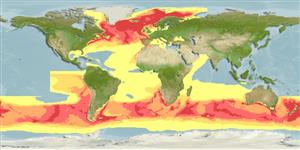Common names from other countries
Environment: milieu / climate zone / depth range / distribution range
Ecologie
Pelagisch; diepteverspreiding 30 - 1800 m (Ref. 122880). Polar; 90°N - 90°S, 180°W - 180°E
Northeast Atlantic, Atlantic Ocean, Indo-Pacific, Mediterranean, and the Antarctic: Central Pacific sector at 68°S, 120°W; Globicephala melas melas: Ungava Bay, Greenland, Iceland, Faroes, Norway, North Carolina, Azores, Madeira, Mauritania, Western Mediterranean, Newfoundland; Globicephala melas subsp.: Japan, Sea of Japan; Globicephala melas edwardii: Brazil, South Africa, Crozet, Heard Island, Australia, New Zealand, Chile, Scott Island, Antarctic Convergence (Ref. 1522). Polar, subtropical.
Length at first maturity / Size / Gewicht / Leeftijd
Maturity: Lm ? range ? - ? cm Max length : 670 cm TL mannelijk/geslacht niet bekend; (Ref. 1394); 570 cm TL (female); Maximaal gepubliceerd gewicht: 2.0 t (Ref. 1394)
Found in oceanic waters and some coastal waters of the North Atlantic Ocean. Feeds on squid and sometimes small medium-sized fish (Ref. 1394). Found in oceanic waters and some coastal waters of the North Atlantic Ocean. Feeds on squid and sometimes small medium-sized fish (Ref. 1394).
Jefferson, T.A., S. Leatherwood and M.A. Webber. 1993. (Ref. 1394)
Status op de Rode Lijst van het IUCN (Ref. 130435)
Status bij CITES (Ref. 108899)
Gebruik door de mens
Visserij: commercieel
FAO - Visserij: landings, soortsprofiel | FishSource | Sea Around Us
Tools
Internet-bronnen
Estimates based on models
Preferred temperature
(Ref.
115969): 1.6 - 10, mean 3.7 (based on 3239 cells).
Weerstandsvermogen
laag, minimale populatieverdubbelingstijd 4,5-14 jaar (K=0.1; tm=12).
Kwetsbaarheid
Very high vulnerability (90 of 100).
Prijsklasse
Unknown.
